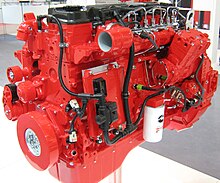History of the commercial vehicle industry
The history of the commercial vehicle industry begins with the invention of buses and trucks at the end of the 19th century. By the First World War , a diverse commercial vehicle industry developed in which numerous companies were involved in commercial vehicle construction. In terms of technology, commercial vehicles developed from designs derived from wagons or carriages to technically more sophisticated vehicles that are still relatively simply constructed by today's standards.
Between the wars from 1918
During the interwar period and the global economic crisis, there was also a consolidation and concentration in the commercial vehicle industry , with many small businesses such as artisanal cartwright and bodywork companies being merged into larger companies.
Especially for the development of the German commercial vehicle industry from the beginnings up to the Second World War:
Rearmament and World War II 1933–1945
While rearmament in Germany and the war economy in World War II brought about a worldwide boom in industrial vehicle production, especially in the commercial vehicle industry, after the Second World War the entire German industry in particular was in ruins, including some of the industries affected by fighting and dismantling other defeated Axis Powers and the areas occupied by the Wehrmacht during the war.
Economic miracle and planned economy after 1945
While mainly from the USA and England, through the conversion of the industries developed under the war economy with increasing mass production, a large supply found a rapidly developing market worldwide, the entire industry in Germany was split into two through the establishment of the Federal Republic of Germany and the German Democratic Republic States with different economic systems divided, so that the history of the German commercial vehicle industry also went its separate ways:
- The economic miracle unfolded in the west , in which the German commercial vehicle industry also experienced a period of prosperity. With the end of economic growth, from the mid-1960s onwards, the German commercial vehicle industry began to consolidate and concentrate on just two major truck manufacturers until 1980.
- Behind the Iron Curtain also had vehicle industry by shortages and planned economy dominated in the shade, however, some creative solutions such as the plastic - body of the Trabant claimed and in particular the two-stroke engine for motorcycles ambitious was further developed.
On the technical side, the commercial vehicle industry was shaped by numerous innovations from 1945 to 1990:
- The front-wheel drive prevailed against the hooded car .
- The vehicles became more comfortable and more powerful. The diesel engine prevailed and, with the gasoline engine and the two-stroke engine, replaced important drive variants.
The main articles, History of the West German Commercial Vehicle Industry from 1945 to 1990 and the History of the East German Commercial Vehicle Industry from 1945 to 1990, provide detailed information about this part of history, especially in Germany .
Development after the end of the Cold War (from 1990)

6 cylinder , 6.7 liter , 224 kW , High Common Rail Fuel System, NLC, Euro 5 (2008)
After the end of the Cold War and the fall of the Berlin Wall , the commercial vehicle market continued to internationalize and new sales markets brought the industry a worldwide boom. Later, with China and other Asian providers, new challengers appeared on an increasingly saturated market. During this time, the increasing digitalization of vehicle electrics with numerous innovations in engine control and vehicle safety prevailed. The further development of the engines was characterized by efforts to save fuel and lower pollutant emissions , in the course of which exhaust gas turbochargers and direct injection became standard.
The main article, History of the German Commercial Vehicle Industry from 1990 to the Present, provides information on this part of history, especially in Germany .
Recent history under the sign of climate change
To this day, the commercial vehicle industry is an economically important branch of the economy worldwide, especially in Germany, which is often under-noticed in the shadow of the more popular car industry. In the context of climate change and an increasing discussion about air pollutants, not only in Germany , the commercial vehicle industry is also coming under new pressure to innovate internationally, especially with buses and rail vehicles to bring emission - free battery - electric ( BEV ) and fuel cell vehicles (FCHV) onto the market as quickly as possible .


